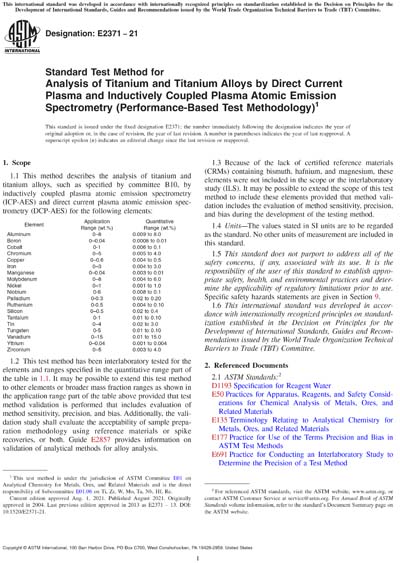Most recent
ASTM E2371-21
Standard Test Method for Analysis of Titanium and Titanium Alloys by Direct Current Plasma and Inductively Coupled Plasma Atomic Emission Spectrometry (Performance-Based Test Methodology)
1.1This method describes the analysis of titanium and titanium alloys, such as specified by committee B10, by inductively coupled plasma atomic emission spectrometry (ICP-AES) and direct current plasma atomic emission spectrometry (DCP-AES) for the following elements:
1.2This test method has been interlaboratory tested for the elements and ranges specified in the quantitative range part of the table in 1.1. It may be possible to extend this test method to other elements or broader mass fraction ranges as shown in the application range part of the table above provided that test method validation is performed that includes evaluation of method sensitivity, precision, and bias. Additionally, the validation study shall evaluate the acceptability of sample preparation methodology using reference materials or spike recoveries, or both. Guide E2857 provides information on validation of analytical methods for alloy analysis.
1.3Because of the lack of certified reference materials (CRMs) containing bismuth, hafnium, and magnesium, these elements were not included in the scope or the interlaboratory study (ILS). It may be possible to extend the scope of this test method to include these elements provided that method validation includes the evaluation of method sensitivity, precision, and bias during the development of the testing method.
1.4Units - The values stated in SI units are to be regarded as the standard. No other units of measurement are included in this standard.
1.5This standard does not purport to address all of the safety concerns, if any, associated with its use. It is the responsibility of the user of this standard to establish appropriate safety, health, and environmental practices and determine the applicability of regulatory limitations prior to use. Specific safety hazards statements are given in Section 9.
1.6This international standard was developed in accordance with internationally recognized principles on standardization established in the Decision on Principles for the Development of International Standards, Guides and Recommendations issued by the World Trade Organization Technical Barriers to Trade (TBT) Committee.
Content Provider
ASTM International [astm]






